How to write a perfect product description - using professional hair care products as an example
Put yourself in the customer's shoes - you decided to look for a new shampoo on the Internet and started Googling. And the result is full of sites with a huge range of products - your eyes are just running wild. If you start to study each product, there is a problem: not all brands of cosmetics more or less digestible description. And very often you can find a product description like this:

And how much did you learn about a particular product? Let's break the text down into theses:
- Revitalizing shampoo;
- Contains keratin;
- Repairs damage and improves texture;
- Makes combing easier;
- Has a special formula that gently cleanses hair and adds shine.
That's about it. If you know the brand or like experiments, you can try it if you like the bottle. But if you do not know the brand and do not like experimenting, you will not buy it, because there is not much information about it and all similar products have similar theses. And in fact - this is a description from the cosmetics catalog, and it is what everyone gets: from managers to customers. It's no wonder that when you come to an offline store and ask about a product, the seller can't tell you anything except these general phrases. And the question arises: how important are such texts for business in general? Are they sufficient for customers of different levels: b2b or b2c? Is it possible to do better? If, yes, what can we write about it? This is what we are going to talk about now.
What is the meaning of a product description?
From a business perspective, product description is important in several ways:
- A way to sell a product without face-to-face communication, as text in paper catalogs or online shops is a way to communicate with the customer. The text can interest the customer or, on the contrary, scare them away if they are not familiar with the product.
- Active sales support from the manager to the customer. Basically, salespeople in companies do not always use the products they sell. Consequently, all they know about the product is what is described in the catalog or feedback from customers (which is not so common). If a salesman knows only two sentences about the product, he is unlikely to be able to say more than that, and this will be a losing position in front of the customer.
- Helps promote your online store in search engines. Everyone knows that quality content on product pages is very important, because search engines appreciate quality texts on product cards. In addition, there is a group of people who read these descriptions and make a choice based on them. The situation can be saved and reviews of products, but … real people, unfortunately, they do not often write them, unless you do not stimulate them, as large stores like Rozetka.com.ua, for example, with offering further discounts.
- Helps partners sell the product if you are importing. On the product page, a partner online shop will probably place exactly the product description which appears on your website or in your catalog. They will not usually add or change anything, as your product is just one of the products they sell, and they are often interested in the overall sales of the store, not specific products. If your partner does not sell well due to a bad description, he will find a new seller and not try to sell your items.
Of course, you can always argue, "I'm not a manufacturer! They need to think more about descriptions, because that's their main interest. I work with what I have". But there is a problem here: regardless of what the manufacturer has written, you have to sell the product, and your success will depend on how you present it. And it's much easier to present the product with a good description. And here's an example:
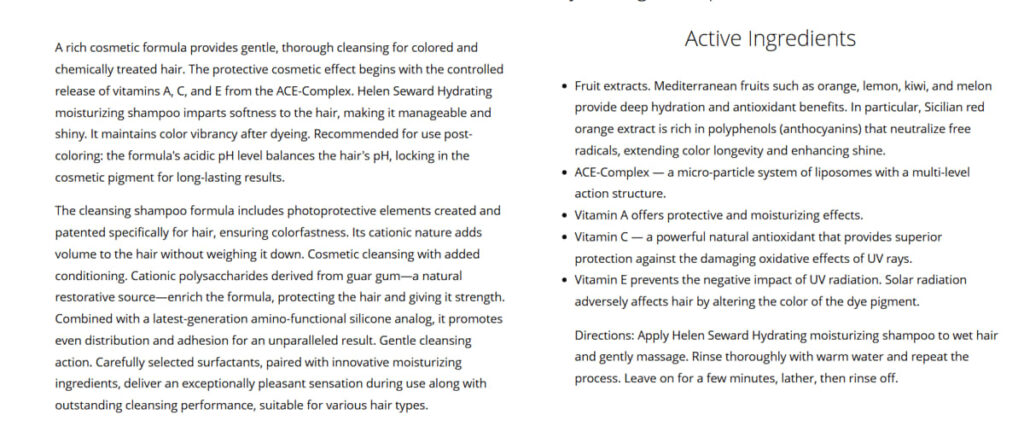
Based on that, there's already a lot to talk about.
Answering this question will be easier if you know the target audience of the product, because each type of audience requires different approaches. It is worth distinguishing the following groups in terms of the valuable business audience that will actually read texts describing professional hair cosmetics:
- Ordinary customers who should understand after reading (so, the writing language should be as simple as possible):
- What is this product for?
- What will he/she get by buying this product?
- How do I use it?
- Salespeople who should understand:
- How do I present a product to a customer so that he/she will buy it?
- What is the value of this product to the client?
- Hairdressers in beauty salons (if we are talking about professional cosmetics) - this group is something between the seller and the buyer, so it is important for them to understand:
- What is this product for?
- What will they get if they buy this product?
- How can they use it in their work?
- How do you sell this product to your customers?
- What is in the composition of the product? (an important question).
- Hair Product Experts (if we are talking about professional cosmetics) - this group usually sells the products to hairdressers and advises them on the application and use of the products. In fact, they should know everything about the brand combined as a customer, as a salesperson and as a professional consultant. It is important for them to know:
- What the product is for;
- The benefits of buying it;
- How they can use it in their work;
- How to sell the product to their customers;
- What the product contains
- How to use the product in the salon practice;
- What salon procedures the product is involved in and how;
- How to perform the procedures.
- Business partners (online shops which sell the product, local agents, etc.). On the one hand, the partners are interested as a seller - they just want to sell the goods. So they will be interested in issues at the seller level. On the other hand, it will be important for the partner to be able to distribute these descriptions in a form that is convenient for him (as a product card in an online shop, product description in a catalog, mailing list, etc.).
- What is this product for?
- What will he/she get by buying this product?
- How do I use it?
Based on these audiences, it is possible to create a set of questions that need to be answered when describing the product:
- What is this product for?
- Where is it used?
- What does it do for the end user?
- How is it applied?
- What is it made of?
- What is the best way to sell the product? (The answer to this question may not apply to all audiences)
In the following, we will take a look at some examples of how such questions can be answered in the text of a cosmetic product description.
What is the product for and where will it be used?
Different cosmetics solve different customer problems. In order for the customer to be able to choose the right product, the text should clearly explain what the purpose of the particular product is. That is, what problem the product can solve for the customer. For example:
- Salon, home or universal beauty product that can be used for both professional and personal use;
- Type of product: shampoo, mask or conditioner;
- Type of problem: for dry hair, for color-treated hair, etc.
What will the client get from using it?
The answer to this question is the most important part of the description. It is not so much about emphasizing the characteristics of the product as it is about describing what will happen after regular use.
How to apply it?
This point is usually very important in the case of specialized cosmetics. When the order of use, mixing proportions with other products, etc. are important for the product. Or if there are restrictions on use (e.g. cannot be mixed with something).
What does the product consist?
A key ingredient in cosmetics is sometimes the engine of product promotion. Especially when there is interest in an ingredient in the market. For example, a few years ago, at the height of argan oil's popularity, all cosmetic brands tried to make a line or separate products with it in the formula and satisfy this fashionable impulse of customers. Some people could buy an unknown brand of cosmetics just because of the price and the trendy ingredient in the recipe.
In the past, it was common to highlight only the most eye-catching ingredients in a product description, the so-called "marketing ingredients", and only mention them in the description with an explanation of how they provide a competitive advantage.
More and more sites have started to publish the full composition of products in the description of items in online shops. On the one hand - this is an additional plus for those who understand and are interested in the ingredients. On the other hand, it is an additional text in the description that can be searched for. In the US market this is a long-standing trend, but in our country it is just beginning to gain popularity.

How do you sell this product?
This can include the rest of the information about the product that was not mentioned in the previous paragraphs. For example:
- answers to frequently asked questions about the product;
- dealing with objections;
- in which salon techniques the product is used and how;
- what is the technology of work in these techniques, etc.
Usually this is internal business information about the product, it is not posted on the pages of online shops, but it is important for effective sales. Therefore, it can be compiled for special product descriptions and for internal use.
What kind of background information do you need to write a cosmetic product description?
To write a quality product description, you need to answer all the previously discussed questions.
Type of product and its impact
The answer to the question "What is this product for and where is it used?" can usually be obtained from the manufacturer. This information is usually printed on the packaging. You may find something like: "Shampoo for all hair types" or "Mask for color-treated hair". This is an established classification among manufacturers as a way of communicating with the consumer. After reading the name on the package, it is immediately clear whether the product is suitable or not, at least by the type of problem. For example: the need to wash dry hair during daily care can be solved by a moisturizing shampoo (shampoo for dry hair) from the home series.
Shampoo for damaged hair for daily care at home.
Salon mask for hair deep restoration. Used only in the salon.
All available information from the manufacturer
Only the manufacturer knows his cosmetics best. Therefore, you should get as much information about the product as possible from the brand. Even the smallest details in the form of a sentence or two about the product, recommended application techniques, etc. can help you in your work.

Usually the manufacturers themselves mention the most interesting ingredients in the product description on the packaging or in the catalog, on which they base the promotion of the product. Even if they only mention them, you can always find the missing information on "chemical" sites on the Internet. Manufacturers of cosmetic ingredients do not hide it.
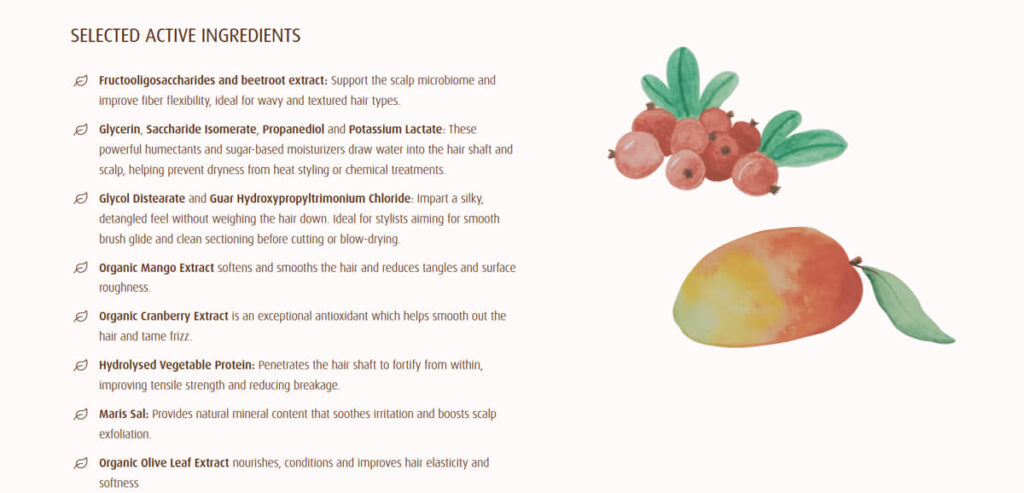
Product formulation features
The specifics of a product's composition can be provided either by the developer or by a chemist who understands cosmetic chemistry. An outsourced chemist will not be able to fully predict the effect of each ingredient in the list on the product packaging because he will not know the exact concentrations. And here their job is to understand the composition in such a way that:
- suggest practical uses for the product;
- highlight the marketing ingredients of the product, if they are not present, or perhaps expand their list if there is something else interesting in the composition, as well as to characterise them;
- give restrictions on the use of the product, if important.
- you can try using it in therapeutic hair treatments with heat;
- can be used to smooth porous hair before colouring;
- contains hydrolysed wheat proteins which moisturise hair and fill voids in damaged hair;
- contains silicones, which create an artificial scale on the hair;
- used only in the salon, as for daily care the mask may be too nourishing and cause a cumulative effect.
Use of FBV (Feature-Benefit-Value) for writing cosmetic descriptions
There are several approaches to writing text for cosmetic products. From my personal experience, I can say that writing a text based on the FBV system has proven to be a good way to do it, and I will talk about it later in this article. The FBV system is the construction of an informative message for commerce or presentation, based on the characteristics of the product, such as its features, benefits and values (FBV).
What is a FBV system?
Features are all the characteristics and facts about a product. Most importantly, they are those that distinguish the product from the general pool of similar products.
- Contains argan oil.
- Mild detergent formulation.
- Fruity fragrance.
- Thick creamy consistency.
Benefits - Distinctive characteristics that exceed similar characteristics of similar products from competitors. In fact, this is the answer to the user's unasked question when reading the features: "What makes the product stand out?
- Moisturises and nourishes hair.
- Gently washes the hair and does not loosen its structure.
- Very pleasant fragrance that you and your clients will love.
- The product does not flow and is easy to distribute on the hair.
Value - the measurable and immeasurable benefits a customer receives from a given product. It is effectively the answer to the question: "What will I get by using this product?". The positive outcome the customer will receive from this product. Usually, the value element is the most problematic when creating schema information because it is less obvious from the product description and speaks more to the problems of the target audience. The following options are worth considering as value ideas:
- making money;
- saving money and/or time;
- comfort;
- ease of work;
- reduction of any effort;
- pleasure;
- health and fitness;
- a sense of belonging to a small circle of people;
- individuality;
- new emotions;
- beauty and much more.
- Your hair will be healthy, silky and pleasant to the touch after using the product.
- With this product, your lightened hair will be safe when washing your hair.
- Feel yourself at a spa treatment or aromatherapy session.
- The product ensures easy application.
The 3 parameters of the FBV should be related and form a logical chain: feature → the benefit that this feature provides → the value that the customer receives thanks to this feature.
Contains Argan Oil (special feature) → Moisturizes and nourishes hair (benefit) → Your hair will be healthy, silky and soft to the touch after using the product (value). Fruity fragrance → A very pleasant aroma that you and your clients will love → Feel like you are in a Spa or Aromatherapy session
This approach to describing product features allows you to reveal the product in its full glory and convince the customer of its value. If you only focus on the product's features and benefits, it will be difficult to sell because the customer is always looking for advantages and a solution to their problem.
Building of the FBV tables
To competently develop a product using the FBV system, you need to look at the needs, fears and concerns of your target audiences and think about what ingredients and features in the formulation can help address these issues. This will give you an outline for the features. Initially, it's better to write such theses to the best of your ability, without thinking "whether you can turn this into value". You can pay attention not only to individual ingredients, but also to:
- Ingredient combinations;
- Flavor;
- The texture of the product;
- Versatility of the product for different procedures (e.g. the product is used in 4 different professional procedures at the same time);
- The firmness or softness of the composition as a whole, etc.
Then, based on the selected characteristics, the benefits and values are already described. And not all the characteristics selected at the 1st stage can give values at the end, so they have to be discarded. If several characteristics give only one benefit, it makes sense to combine them. If interesting product characteristics have been identified during testing, you can use them. Find the feature that provided that feature and the value the customer gets.
- advantage - good fixation;
- feature - excellent polymer composition or a blend of PVP and VA polymers or a strong fixative base for the product;
- value - your hairstyle will last a long time even if you dance (your style will look like you just left the hairdresser, even at the end of the party).
In the end, you should end up with one table for each of your products.
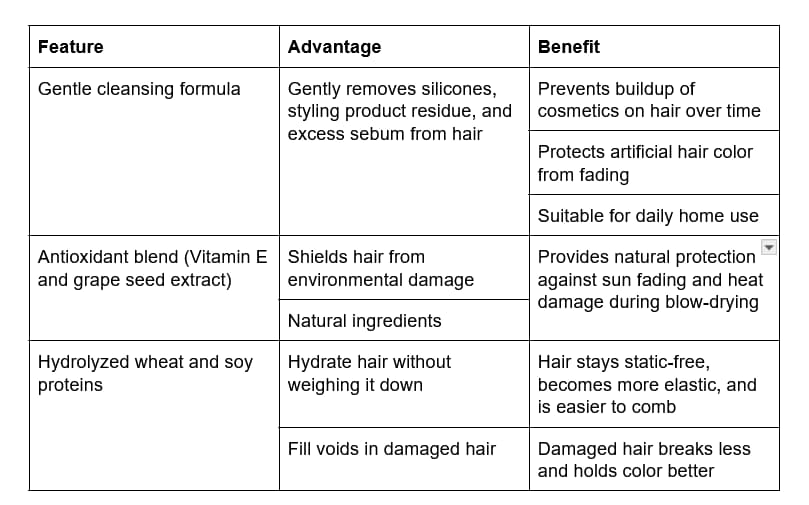
It is absolutely necessary to take into account all available information about the product (from the technologist, the chemist, the sales department, the manufacturer) when compiling the FBV tables, in order not to overlook anything and, in the end, to make the product description as useful as possible for every target audience.
Writing product description
Now that all the preparatory work is done, you can move on to writing the text. For its logical development, it is worth remembering the questions that arose during the target audience analysis:
- What is this product for?
- Where is it used?
- What does it do for the end user?
- How is it applied?
- What is it made of?
- What is the best way to sell the product? (The answer to this question may not apply to all audiences)
By answering them one by one, you can write a description of the product. And no one says that it must be one continuous piece of text - you can use lists, informative inserts, etc.
For example, let's take a shampoo for colored hair, a fragment of the FBV table above. Let's try to write a description of the product for a customer who is going to buy it for himself or herself.
Shampoo Name Shampoo for coloured hair is formulated for the daily care of hair after colouring. It is an ideal option for use at home.
It contains hydrolysed wheat and soya proteins, thanks to which it moisturises the hair without a greasy effect and fills voids in damaged hair. With regular use, hair will be supple, easier to comb and less likely to break.
Thanks to its mild detergent formulation with neutral pH, which gently cleanses the hair of cosmetics, styling products and sebum, it helps to prolong the durability of colour.
Product Features:
- Gentle cleansing and maximum preservation of artificial hair colour.
- Contains hydrolysed wheat and soya proteins.
- Contains a blend of antioxidants based on vitamin E and grape seed extract, which protects hair from the negative effects of the environment, it prevents them from fading in the sun and damage when blow drying.
- Neutral pH.
- Facilitates combing of hair.
- Available in 250 and 1000 ml bottles.
If we need to describe the product for a different audience, the information blocks can be modified and added. For example, the product description for hairdressers might be (italics are changes and additions):
Shampoo Name Shampoo for coloured hair is formulated for the daily care of hair after colouring. It is the perfect option to recommend to clients at home.
It contains hydrolysed wheat and soya proteins, which makes it moisturises hair without the greasy effect and fills voids in damaged hair. With regular use, hair will be supple, easier to comb and less likely to break.
Thanks to its mild detergent composition with neutral pH, which gently cleanses the hair of cosmetics, styling products and sebum, the shampoo will maintain colour fastness after colouring and will help to avoid customer complaints about the rapid washout of colour.
Product Features:
- Gentle cleansing and maximum preservation of artificial hair colour.
- Contains hydrolysed wheat and soya proteins.
- Contains a blend of antioxidants based on vitamin E and grape seed extract, which protects hair from the negative effects of the environment, it prevents them from fading in the sun and damage when blow drying.
- Neutral pH.
- Facilitates combing of hair.
- Available in 250 ml bottles(great for first time customers) and 1000 ml bottles(economical packaging for beauty salons and thrifty customers).
- A light, pleasant fragrance that will suit most clients.
It is advisable to recommend the product to clients for home care together with a mask and conditioner from this series, which will give maximum effect on colour maintenance.
The product is not used as an acid shampoo to stop the reaction of lightening and colouring, as it does not have acidic properties. There is a "Product 2" for this purpose.
"Name Shampoo" can be used for "Colour Bath" and "Decapping" techniques.
What else could be added to the product description?
Once the basic product description is written, you can think about adding more information to maximize the display of the product from all sides. Here you can give:
- Instructions on how to use the product.
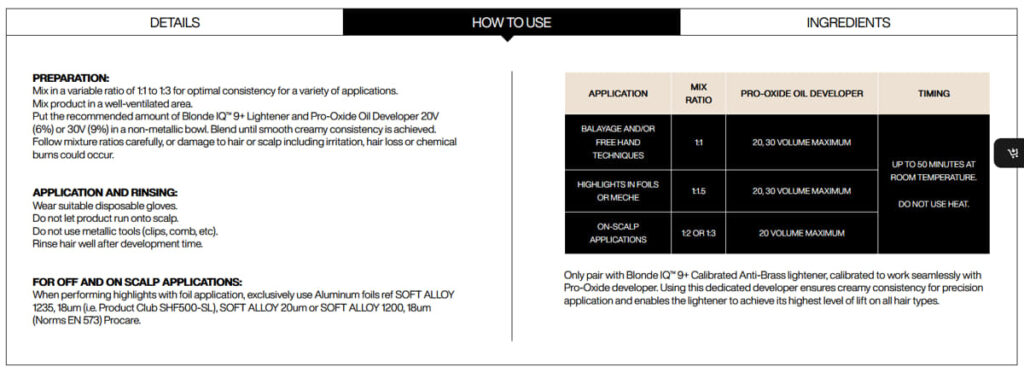
- A full list of ingredients from the product packaging (which has already been mentioned).
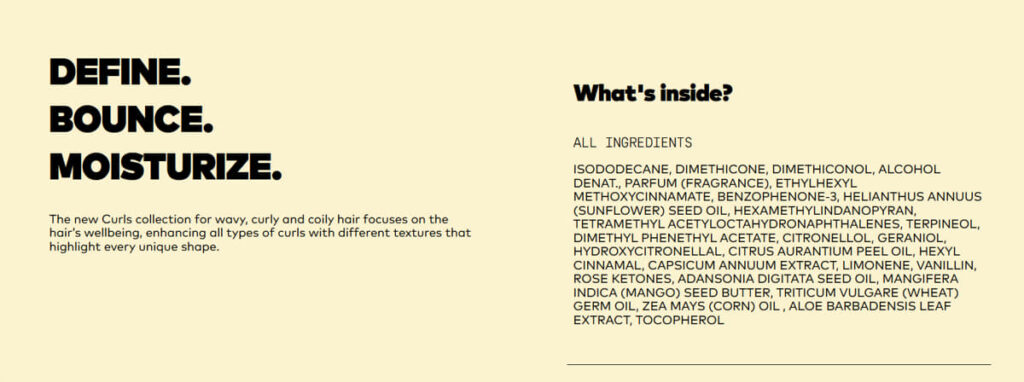
- Explanation of the technologies incorporated in the product composition.
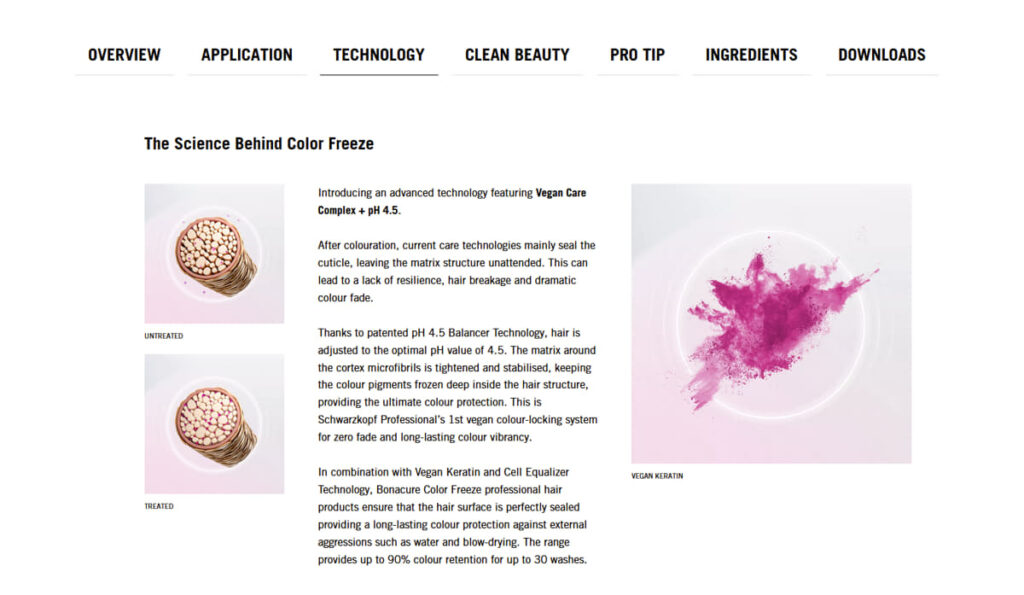
- Extended help on the properties of the ingredients mentioned in the description.
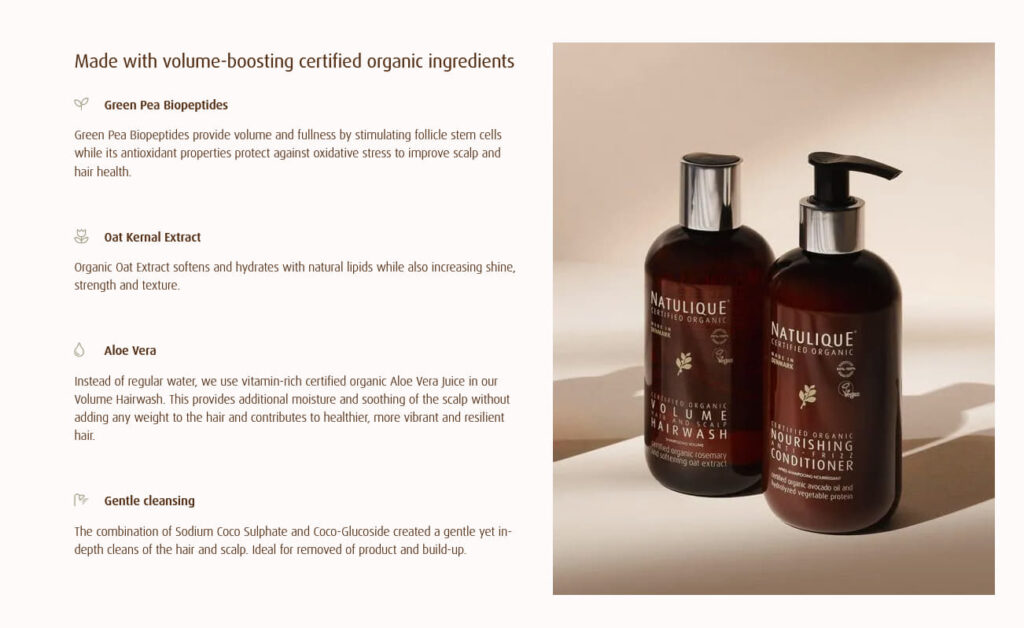
- Photos and videos of the product, if available.
- Technical characteristics of the product (here it is worth highlighting exactly those characteristics by which products can be classified).

- Additional important information on specialised products like hair dye palette photos and descriptions.
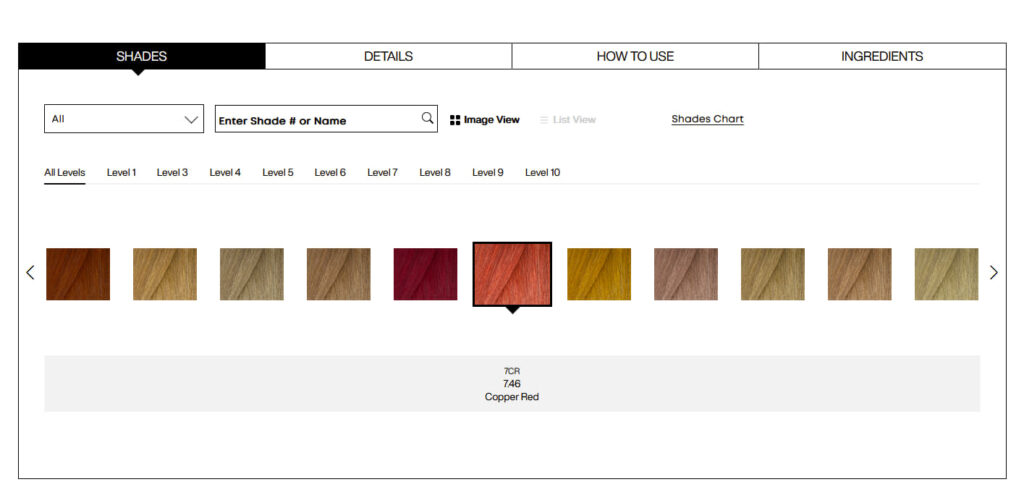
- A little emotion in the product description, descriptive words and creativity if writing for an audience of end buyers, especially women (it's like spicing up the text, but it shouldn't replace the content of the text):

What needs to be considered when writing a cosmetic description?
Despite the common misconception that no one reads product descriptions, this is far from true. There are always groups of people for whom a quality description is one of the key points when choosing a product. After all, no one wants to buy a cat in a bag. Therefore, it is important to keep the following points in mind:
- Identify your brand's target audience and their needs;
- Collect as much information as possible about the product: its advantages, disadvantages, limitations, features, etc. ….;
- Create FBV (Feature-Benefit-Value) tables for each product in preparation for writing the copy;
- Write qualitative descriptions based on the PCA tables for each product, taking into account the needs of the target audiences (in some cases, several descriptions will need to be written for each product, depending on the target audiences);
- Do not forget additional information that can be included in the product description (especially if this information is important)..
All of this will make your description informative, without watering it down and using generic phrases that say nothing. For example, "a delightful scalp wash with a pleasant scent that is simply gorgeous and incomparable" or "up to heaven, a new height, invigorating, life-giving, flying, passion".
That's what reviews are supposed to be, not product descriptions 🙂
